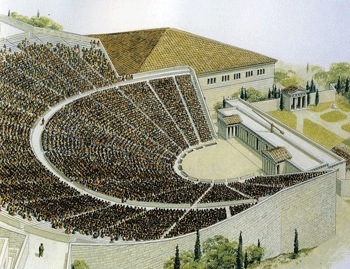 The first ‘true’ alphabet was created by the Greeks in the eight century BCE and is predated by the oldest known forms of Greek writing known as Linear A and Linear B. The often cited “Father Of History”, Herodotus, recorded that this was an adaptation of the Phoenician alphabet (limited to only consonants), merged with elements of their own language.
The first ‘true’ alphabet was created by the Greeks in the eight century BCE and is predated by the oldest known forms of Greek writing known as Linear A and Linear B. The often cited “Father Of History”, Herodotus, recorded that this was an adaptation of the Phoenician alphabet (limited to only consonants), merged with elements of their own language.
As Myths existed long before the rise of documentation and literature, they where created and preserved in what is known as Oral Tradition. This is the tradition of storytelling performed by Bards, a very important and respected position within the culture of Ancient Greece.
Many Myths are truly epic in scale, making the task of the bards to memorise and recite them to an audience a formidable one. This is why we see much of Mythology preserved in the medium of Epic Poetry; a format which makes use of rhyme and rhythmic delivery, particularly Hexameters. Bards would also draw from a catalogue of stock phrases and descriptive names, or ‘Epithets’, which would be repeated throughout the telling of the tale. Memorising such epic tales in this way gave them structure and cadence, making them much easier to recall from memory. When people began to capture culture in the written word, these elements became characteristics of the classic mythological texts.
Professor Meineck points out that The origin of Myths in the Oral Tradition makes them “highly mutable”, meaning the details and plots of myths would change in the telling and in the hands of the many Bards acting as their custodians. Bards, and therefore Myths, would travel great distances over long periods of time and would adapt and change to accommodate their audience.
Of course myth was also captured in other forms of Art. Literature may have become a foundation of civilisation, but reading and writing was not yet a skill available to everyone. The transcribed records of myths would serve as scripts performed as plays, allowing entire communities to enjoy them. Many cultures have unique artistic styles across various disciplines from paintings to sculptures, often inspired by that cultures distinct mythology. Archeological discoveries have often revealed less sophisticated examples of mythological art adorning even simple household objects.
————————————————————————————————————————————
References
Blackwell C W, Hackney Blackwell A, 2002, ‘Mythology For Dummies’, Wiley, Indiana
Meineck P, 2004, ‘Classical Mythology: The Greeks’, The Modern Scholar, purchased from http://www.audible.co.uk
Pictures From
http://www.college.columbia.edu/core/content/herodotus
http://www.timetrips.co.uk/beginnings_of_greek_theatre.htm
http://www.shmoop.com/zeus-jupiter/photo-zeus-with-thunderbolt.html
http://www.ehow.com/facts_5757255_greek-mythology-pottery.html
————————————————————————————————————————————


